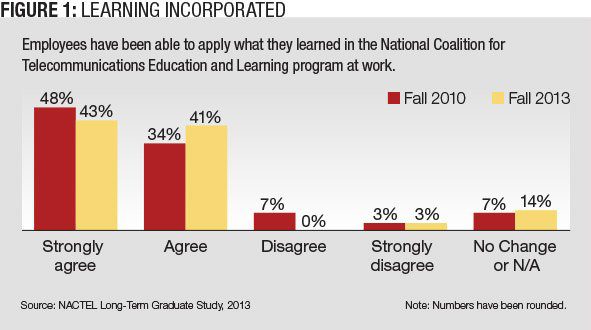Since Starbucks Corp. launched its College Achievement Plan in June 2014, companies have been reconsidering their tuition reimbursement investments as a way to build their brands, improve recruitment, engagement and retention, and deal with workforce skill shortages.
It’s a necessary step to help combat critical positions that go unfilled too long. Applicants who have potential but lack the required certifications and degrees would therefore be lost as higher skills levels are required at all levels. Tuition reimbursement is also a boon for current employees who are frustrated by a perceived lack of opportunity for advancement and productivity hampered by low skill levels.
Learning leaders are often caught between a rock and hard place as these forces converge. They must engage the workforce in learning, and ensure it sticks and leads to increased productivity. Learning leaders also face the complex world of higher education, which is undergoing its own shifts as questions of cost efficiency and customized degrees loom.
By listening to learners — whether learning occurs through a college course funded by a tuition assistance benefit or through an internal program — and developing strategies everyone can follow, companies can make sure learning counts and meets employees’ as well as the organization’s business goals.
Making a Way for Education
For many of today’s adult learners, innovative programs play a significant role in their pursuit of a college degree.
After working with regular phone lines at AT&T Inc. for 18 years, John Mondala, an AT&T force load analyst in Streamwood, Illinois, returned to school. His employer told him about how the National Coalition for Telecommunications Education and Learning — which is known as NACTEL and is a collaboration of industry employers and unions — was working with higher education institutions to create and sponsor online education programs that meet current and future telecommunications professionals’ needs, such as an associate’s degree in telecom or mobile technology or a master’s degree in Internet technology.
AT&T provided Mondala with full tuition, and he dedicated his free time to earning an associates degree in wireless technology and a certificate in telecommunications essentials. With a family and a full-time job, he worked nights and weekends to finish his degree and certificate ahead of schedule.
Mondala said part of his success was his experience with prior learning assessment, a method organizations can use to evaluate workplace learning and other learning experiences for college credit. He took a course that showed him how to document his learning and apply it to other course credits he needed to complete his degree. With a prior learning assessment, he also earned additional credits. “The work was very extensive, very demanding and very time consuming, but that was a huge factor in my ability to complete my degree ahead of schedule,” he said. “You really do need to manage your time and take this class very seriously for it to be beneficial, but if you do, the payoffs are tremendous.”
Mondala said employers need to know a few things about adult learners to help them be successful. For instance, the relationship has to be a two-way street. Learners need to communicate to their employer that they are willing to go to school and be proactive in asking the employer what skills and knowledge the company values.
Likewise, the employer should show interest in the learner’s progress, providing them with opportunities to showcase their newfound knowledge in ways that could be beneficial to the organization. “I was fortunate to be surrounded by people who were excited and encouraging while I was in school,” Mondala said. “My bosses allowed me to use many facets of my studies to better our department.”
Mondala also emphasized the importance of employer support in his success, which he said he received from day one. “They allowed me to use our office for testing with my proctor, and they even allowed me to conduct an in-house seminar for tuition aid and schooling to assist my co-workers who were interested in going back to school.”
He said his experience also has been helpful to his employer in multiple ways. First, they were able to see the drive and determination that enabled him to earn his degree and certification, which illustrated clearly that he was willing to work hard and diligently at any task he was given. Second, his course work enabled him to incorporate things he learned from his studies directly into daily tasks and functions at the office (Figure 1).
Industry-specific training programs like the NACTEL program also have been shown to bring a host of other benefits. According to a long-term NACTEL Graduate Survey conducted in fall 2013, program graduates reported the program delivered a variety of positive effects on their professional life (Figure 2). Specifically, they:
- Felt the program had a positive effect on their work.
- Felt the program improved their job performance.
- Felt that as a result of the program, they had a better understanding of the industry.
The Best Laid Plans
Employers also might consider career advising, which can be a vital link to help employees better navigate their many options and choose more fulfilling development and career paths. Trained advisers who understand the company’s talent needs can assess an employee’s interests and abilities.If they are not aligned with a particular education provider, that company adviser can directly recommend alternatives online, over the phone and in person to help streamline the education process. This activity has multiple benefits. It can translate into meaningful savings on tuition and books. Even more important, employees who take advantage of career counseling services often have a higher rate of course completion and are promoted more often.

Margaret Fuller, production planner and Mercury brand ambassador at Mercury Marine in Fond du Lac, Wisconsin, is currently in school full time. She was managing a full-time school schedule with a full-time work schedule when she learned about her company’s career advising program. She signed up and was appointed an adviser who helped guide her in a direction where she could obtain college credits from her work experience.
Fuller said the advising services played a key role in her success, helping her find resources she needed to contact the school and gather the information that she would need to obtain prior learning credits for occupational experience. The adviser called and emailed to check on her progress and offered extra ideas and solutions where needed to help her meet her goals.
“This was much needed for me,” Fuller said. “I really didn’t have any direction laid out, a direct path to follow, or even understand what was available from my employer or from my school. My adviser really helped me bring schooling and work together in a way that brought out my best potential for reaching my goal. It also demonstrated that someone believed in me and had faith in my ability to set out and accomplishmy dreams.”
With her adviser’s help, Fuller was able to obtain college credits toward her degree in four classes, which translated into 12 credits. “My prior learning assessment saved me a whole semester of time and only cost one third of the tuition.”
Companies don’t just query whether to provide tuition reimbursement benefits. They query how much to provide and when in the educational process to provide them.
Aimee Sumereau, senior technology engineer for Brookhaven National Laboratory, said employers should structure their college assistance programs so tuition costs are covered upfront. Her employer covered 75 percent of tuition expenses upfront for her associate and bachelor’s degrees if she maintained certain conditions. Near the end of her associate degree, she found out if she completed her undergraduate degree, her employer would reimburse her for the 25 percent difference.

“That really motivated me to continue to pursue my bachelor’s degree. Even better, I was then driven to just keep going to earn my graduate degree partly because my employer generously covered 100 percent of that tuition upfront,” she said. “Having the program structured in such a manner made the experience much more manageable for me.”
Learning leaders who are interested in helping their employees succeed must maximize the knowledge and experiences these workers already have, be flexible, and provide support to help them make wise education choices. Today’s educational environment includes a wealth of nontraditional options to help make learning for adults easier and less expensive.
Without proper direction and easy-to-use resources, employees often get lost in the morass of too many choices — wasting their drive and diminishing their potential to strengthen the organization. But if we support adult learners, we can make all learning count.















